Thought we’d take a break from the invasive discussion (I have some throughts I’ll weigh in with on Mon.) In the meantime, here’s a photo of dwarf Alberta spruce not too far from my boyhood home in Olympia, WA. I get 2 or 3 of these calls each year; usually with a homehowner exclaiming, “I’ve got a tree growing out of my tree!”.
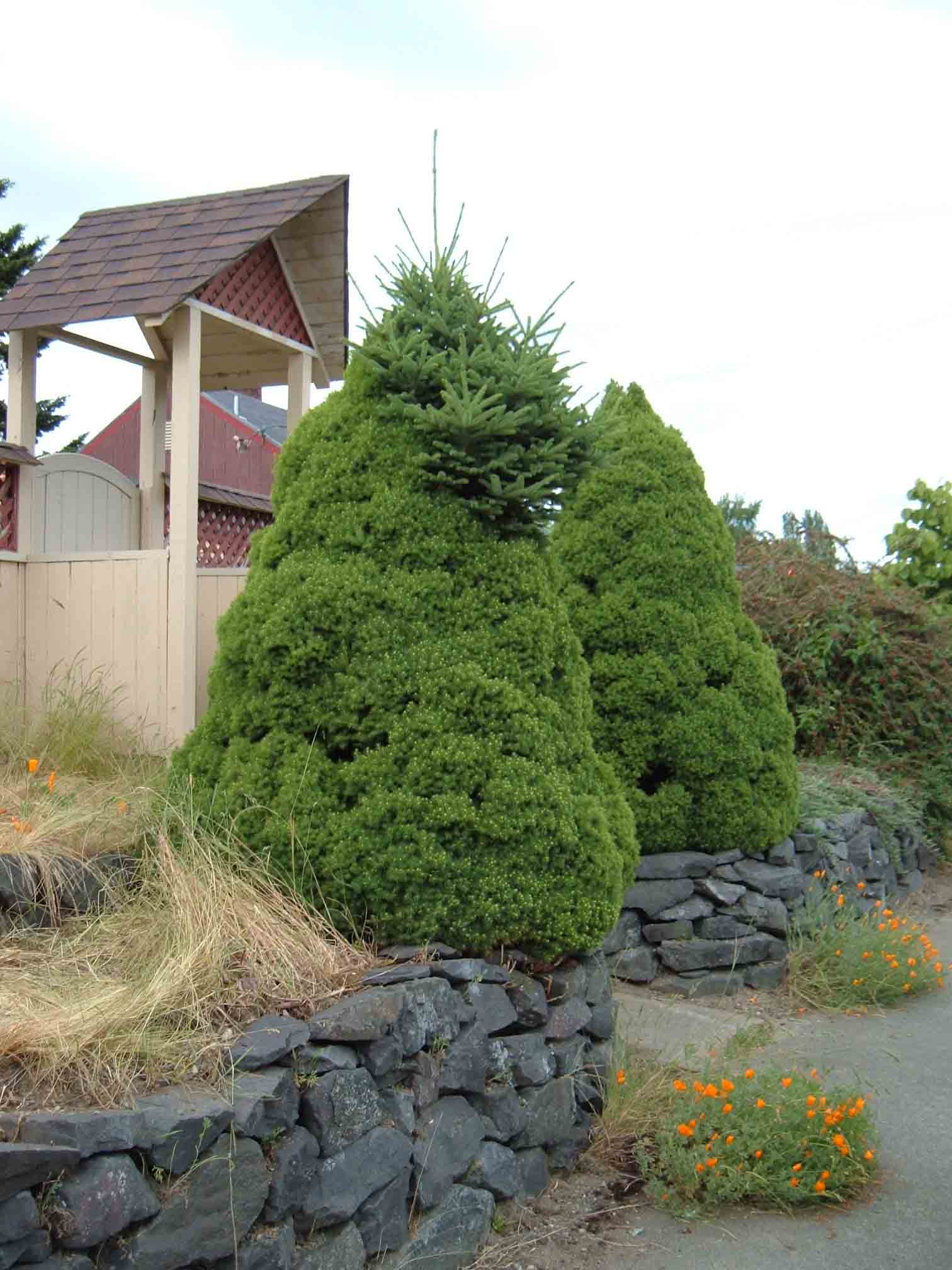
Month: December 2009
A thought about Invasive Plants
Recently there was an article published in the journal Science (widely considered one of the most prestigious science journals in the world) by two professors who I knew while I attended college in Pennsylvania (Franklin and Marshall College — Anyone ever heard of it?). I found this article particularly interesting because it explained how the beautiful Pennsylvania scenery that we assume is natural was actually created over the course of three hundred years. Saw mills and dams changed water flow patterns — those pretty streams that flow through the Southeastern PA (and nearby areas) that I grew up in aren’t natural at all.
Of course this is just another thing that we’ve done to make this country different from what it was when people first came here. We’ve also farmed the heck out of the land, built large industrial areas and, on top of that, there’s the issue of global warming (which, for the sake of this post, we’ll assume is caused by humans), increased carbon dioxide in the air, decreased top soil and forest land (mostly because of the farming), and a general increase in soil, water and air pollutants.
So, with all that said, It seems to me that we’ve done a lot of things to change the environment. With all that we’ve done why are we so upset when some plants, which we call “invasive” thrive in these settings? It’s not their fault that they do well in the conditions we’ve created. Sometimes I feel like we’ve built this great big smorgasbord of lutefisk (fish treated with lye — it’s pretty nasty) and then get angry when only people who grew up eating this type of fish come to the party.
I’m not trying to promote invasive plants — And I’ll be the first to admit that this post is oversimplifying the whole question of invasives — Still, it irks me sometimes that we aren’t more concerned about the environment where we plant our greenery rather than the plants themselves who, after all, are just feeding on the smorgasbord that we’ve created.
Notice Any Similarities to Compost Tea?
Linda sent me a link to This Comic the other day. Funny stuff — and not a little bit analagous to our friends who think that compost tea is the cats meow!
Veggie garden safety
A few months ago I posted a caution about using old pressure-treated timbers for vegetable gardens (see my Sept. 23 posting). I now routinely get questions about alternatives to these arsenic-laden materials, especially new treated lumber. What’s in the new wood that makes it rot resistant, and is it dangerous?
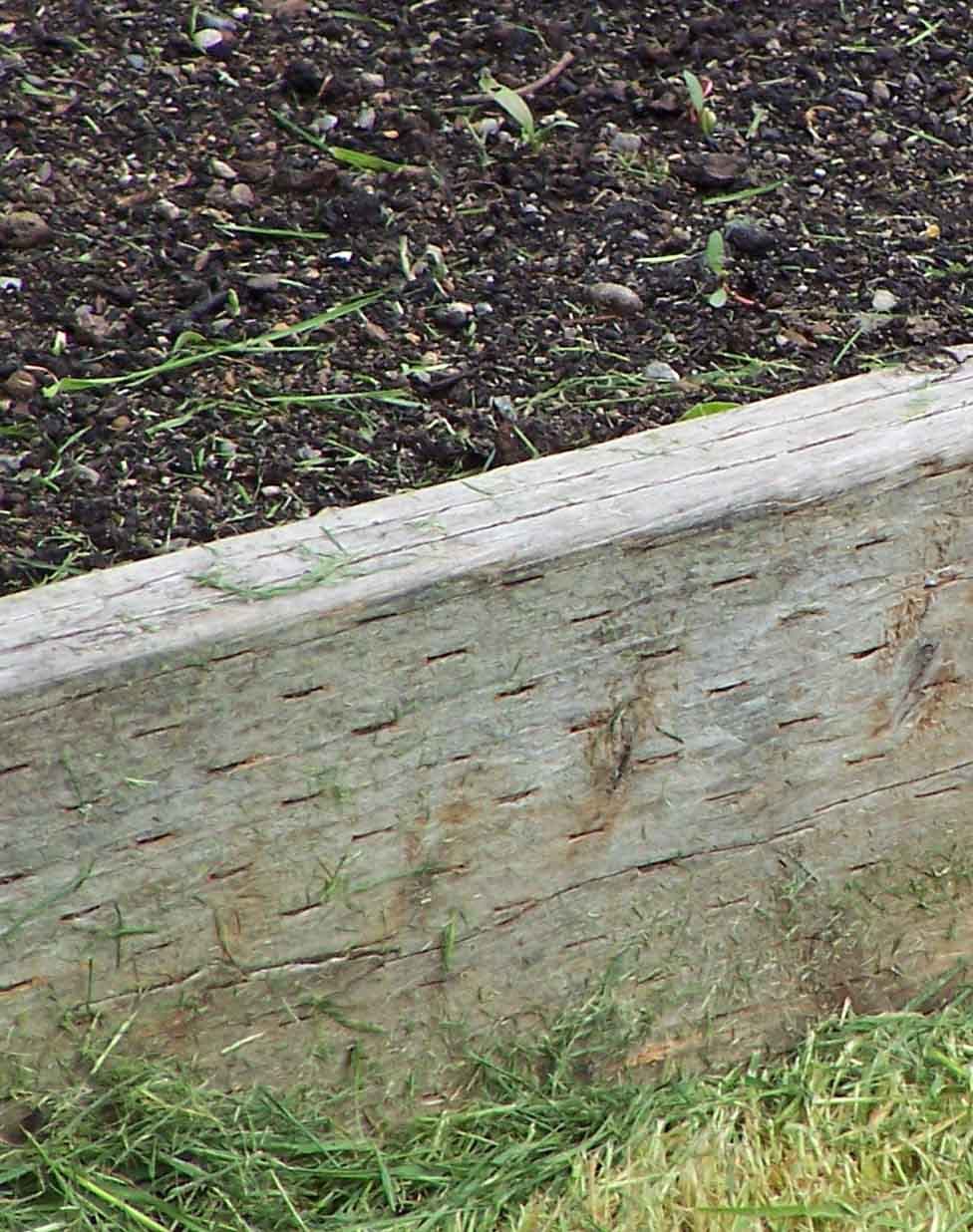
Rather than arsenic, new pressure-treated lumber has copper as its active ingredient. Though it also will leach out of the wood, there is not a human health hazard associated with its uptake by plants or animals. You probably get more copper leaching into the water carried through your plumbing (assuming you have copper, and not lead, pipes).
What about plastic timbers? Though I’ve not seen any literature about leachates from plastic lumber, I’ve seen some older plastic timbers that haven’t aged well – they can warp and twist. I would avoid those made of rubber, because decomposing rubber produces leachates that are quite hazardous (see September 30 for a discussion on rubber mulches).
Of course, there are many other materials one could use to corral their veggies – concrete blocks, stone, natural wood, etc. Do you have a favorite? Post a comment to let us know!
Growing a greener Christmas tree
Among the many hats I wear, one of the most enjoyable is that of an Extension Specialist working with Christmas tree growers here in Michigan and surrounding states. I suppose part of the satisfaction stems from the fact that my first real job was shearing Christmas trees in southwest Washington during my high school summers. To give you an idea how long ago this was, the minimum wage when I started the summer between my sophomore and junior years was $2.20 per hour.
Today I’m involved in a variety of projects related to improving sustainability of Christmas tree production, particular water and nutrient management. One of our major focus areas has been the development of container production systems for living Christmas trees. For those not familiar with the concept, living Christmas trees are conifers that are sold with their roots intact as opposed to a cut Christmas tree. Living Christmas trees serve a niche market for people that think cutting a Christmas tree is wasteful or even harmful to the environment (never mind that virtually every Christmas tree cut in the US was grown on a plantation for that express purpose). Many Christmas tree growers have sold living trees by digging trees from their fields and selling them balled and burlapped or placing them in containers. In our current work we’ve focused on growing several species of conifers as container stock with the end goal as living Christmas trees. Container growing imparts a couple of advantage over the B&B method. First, container-growing eliminates loss of roots associated with field digging. Second container-grown trees are much lighter weight for consumers to handle than field-dug trees. Also, we have found the container-grown trees survive post-holiday storage and transplanting better than field-dug trees.
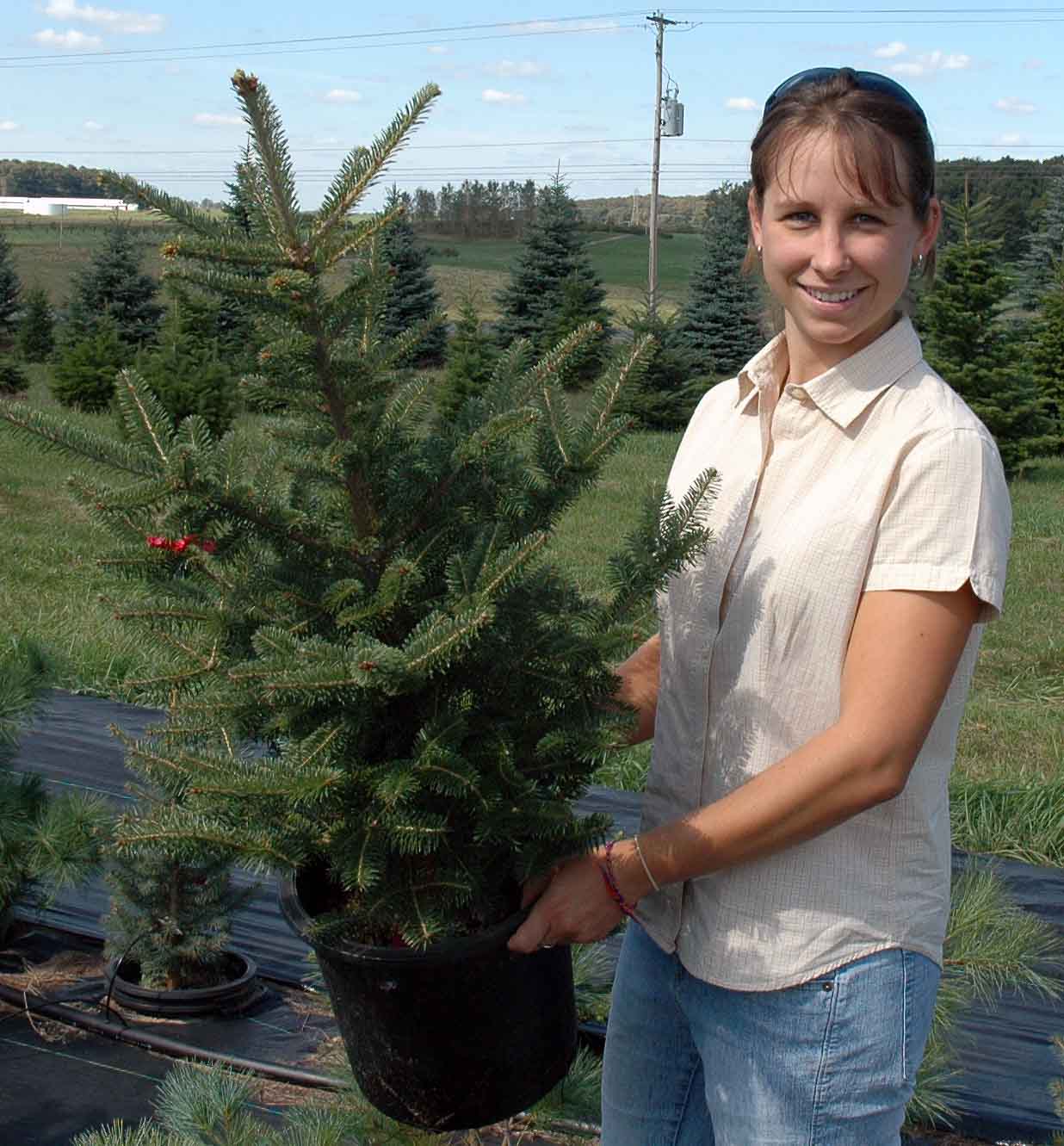
My former grad student, Wendy Klooster, shows off one on the Fraser firs she grew as part of her MS project on nutrient management.
If you’re considering a living Christmas tree here are some things to keep in mind.
- If your ultimate goal is to plant the tree in your landscape, make sure the tree is a species that’s hardy in your location. There are several types of container-grown conifers such as Italian stone pine (Pinus pinea) sold in big box stores and super markets that are hardy in only the warmest parts of the country.
- Limit display of living trees to 10 days to two weeks. Most conifers will begin to lose dormancy shortly after being brought indoors. We’ve observed that some, such as Black hills spruce (Picea glauca var. densata), will break bud if the weather has been cold and they’ve had sufficient chilling.
- After the holidays, place the living tree in a protected but unheated space such as a garage or enclosed porch or patio. The key here is that the tree needs some exposure to light – but avoid direct sun.
As with just about everything these days, the environmental friendliness of Christmas tree production is receiving increasing scrutiny. One way to have the ‘greenest’ tree on the block is to bring home a tree that keeps on giving.
Friday puzzle solved!
Great discussion over the weekend, with some very astute observations. If you looked at the brown needles under the tree in Friday’s picture, you may have noticed that some of them weren’t needles:
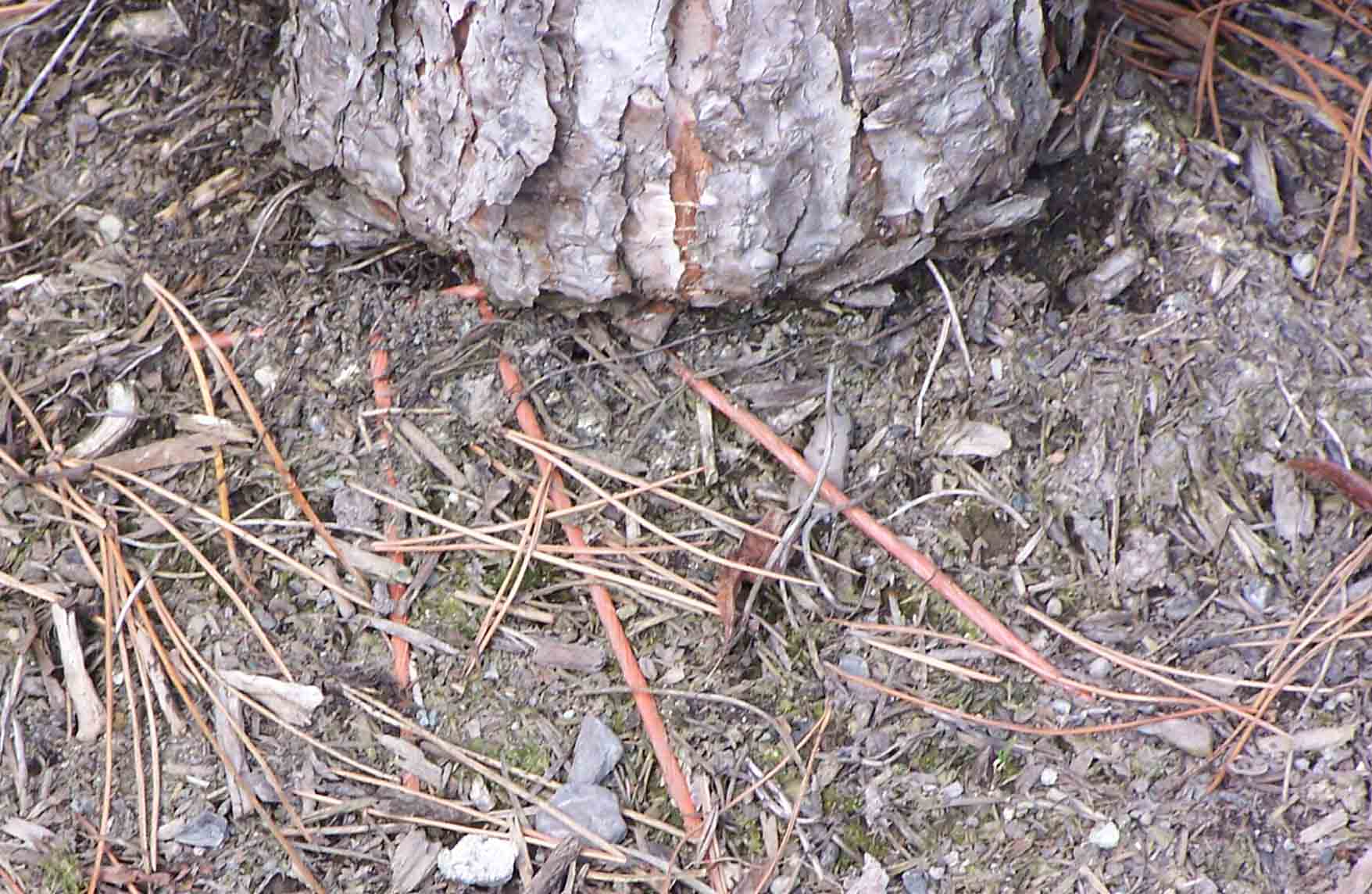
Not only was this tree planted too deeply, as several of you pointed out, but the burlap and twine were left intact. It appears the nylon twine has already started to girdle the trunk, based on the trunk swelling just above where the twine is wrapped.
I’ve ranted about this practice already, so I’ll just sigh and move on to the first question – what directly caused the needle drop from the lower part of the tree? It’s a young tree facing west so the lower half gets plenty of sunlight. And though needle drop is normal with all conifers, the upper portion of the tree does not show the same drop with its interior needles. My guess is that ethylene gas is responsible.
Plant roots under stress often release ethylene, a natural plant growth regulator more commonly associated with fruit ripening. It also induces leaf drop, so as it percolates out of the soil it affects the lower leaves, but dissipates before it reaches leaves higher in the crown. It’s a common phenomenon with over-watered house plants.
Thanks to all of you who participated in the diagnosis discussion – this is more fun than my 20 years of college teaching!
Friday fun!
It’s the holidays, but this pine tree is feeling anything but merry. It was installed about a year ago. While the upper foliage looks lush and green, the lower branches have no new needles and in fact the current needles are dropping:
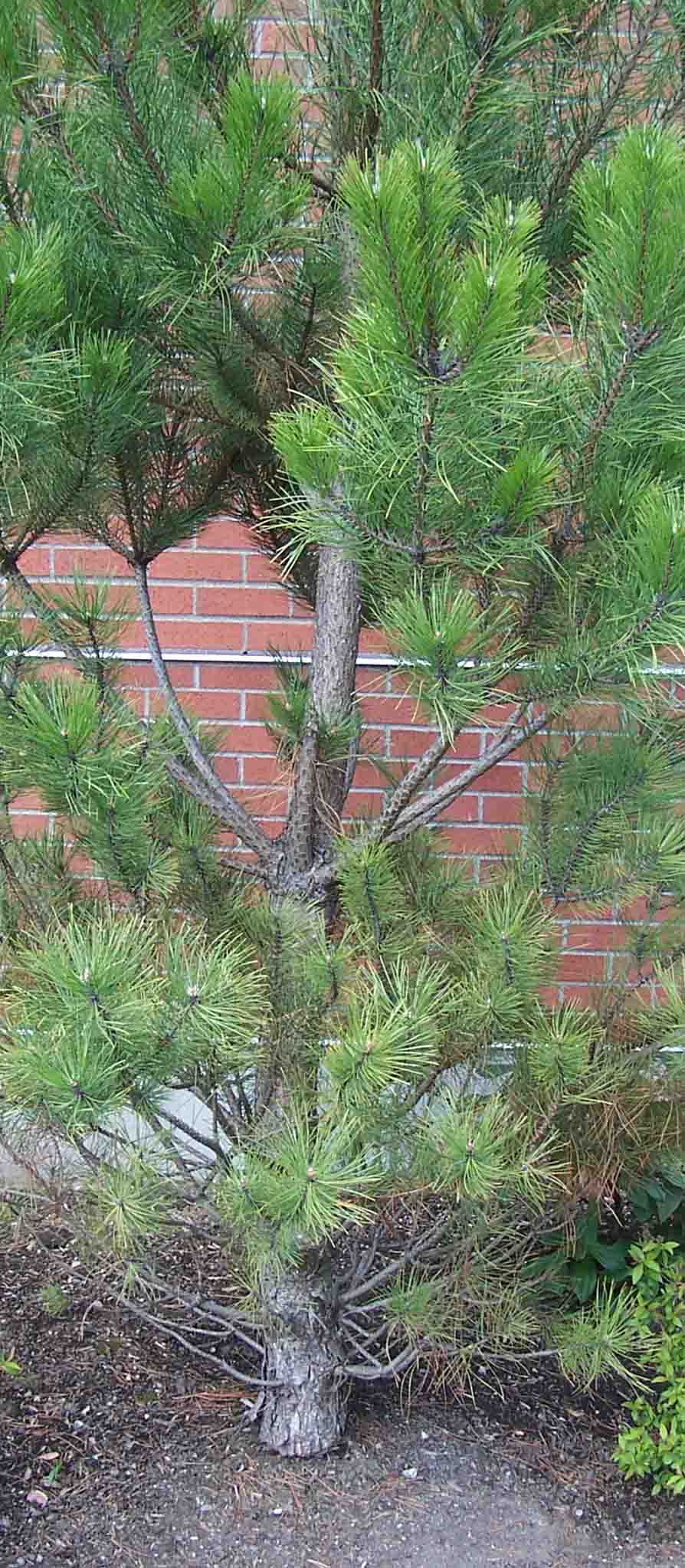
This is a two part question:
1) What might be directly responsible for the needle decline on the lower branches? (Hint: this is caused by the plant itself.)
2) What might be the underlying stress causing the needle decline? (Hint: this is caused by by people.)
Additional photos on Monday will reveal all!
Let It Snow!
Here in Minnesota one of the things that we need to worry about is the cold. Over the winter we can see temperatures down into the -30s (even the -40s in the Northern part of the state) and it can damage many of the plants that we grow. The tops of the trees are usually able to handle these types of temperatures — though a good heavy snowfall can cause a limb to collapse now and again.
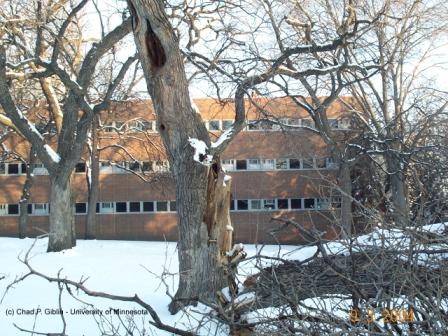
The bigger problem is with roots which aren’t able to handle the cold like the top of a plant can. Once you get 10 degrees or so below freezing you’ve killed the roots of most plants. Fortunately the ground is a great insulator and doesn’t get nearly as cold as you’d think. Once you get two or three inches under the surface of the soil temperatures will hover right around freezing for most of the winter. The plants that are most susceptible to cold are those that are in containers because their roots are above the soil’s surface. Nursery growers usually protect containers from the cold by consolidating them (pushing them together as in the picture below).
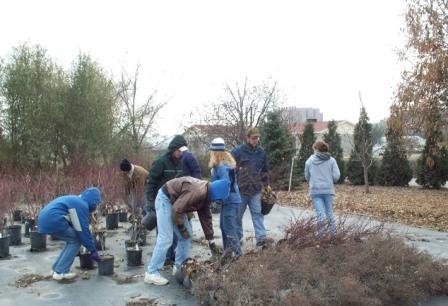
These containers are then covered with a layer of polyethylene fabric, about 6 inches of straw, and then another layer of polyethylene fabric. Temperatures under the fabric rarely go below 26 degrees or so — even when outside temperatures stay around -20. Most plants come out fine — our biggest problem is that sometimes voles and mice will take up residence under the tarp and eat the plants — which isn’t a big deal unless its a research project — in those cases we will often use poisons or, more frequently, repellents.
The only thing better than this method is snow. If we could count on snow every year we wouldn’t bother covering the plants at all. Snow is the best insulator that we have. Under snow temperatures rarely go below 29 degrees or so. So, despite the traffic problems that snow causes, nurserymen and landscapers are always happy to see snow on the ground before the really low temperatures hit.
Inspecting nursery plants, part IV
(Note: this is a really LONG post. Not in text – but in photos! Sorry for all the scrolling.)
I don’t know about you, but after spending three weeks on my hands and knees looking for trunk rots, surface roots, and suckers, I’m ready to become bipedal again. So today let’s look at trunks – and what shouldn’t be missing on them.
Many young trees have numerous short branches along their trunk, as shown in the photo below:
>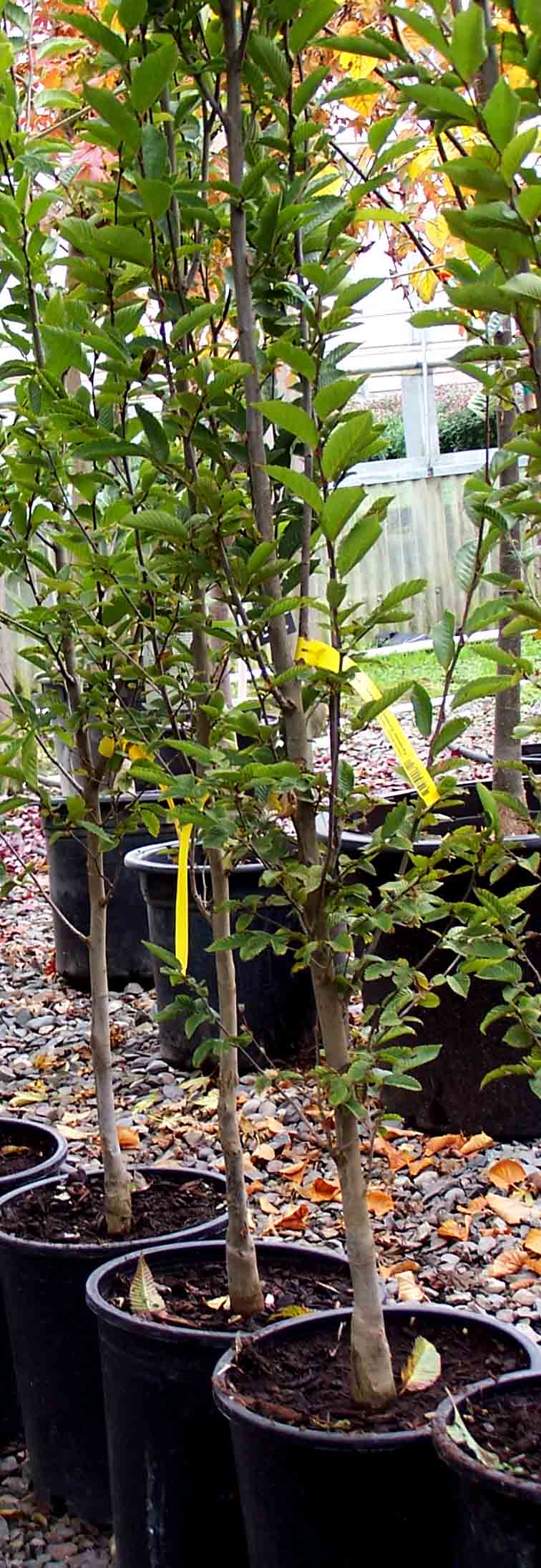
Unfortunately, many nurseries and gardeners think this looks scruffy, and respond by pruning these branches off, leaving a tree such as the one in this picture:
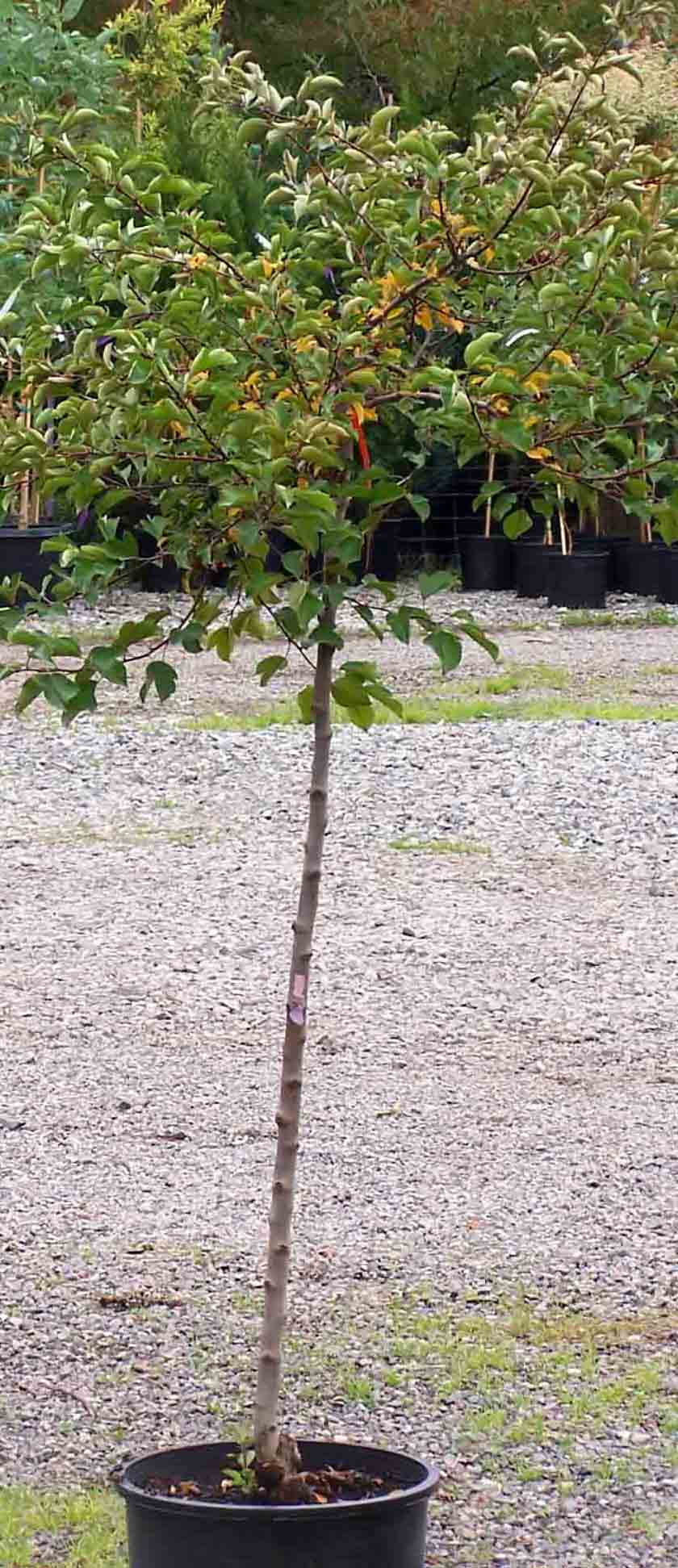
Personally, I think these trees look like lollipops, but aesthetics aside, this type of pruning can inadvertently damage young trees. Their bark is often thin and sensitive to environmental stress – especially sunburn. Without those short branches deflecting the sun from the bark surface, the living tissues under the bark can be killed, creating dead patches on the trunk:
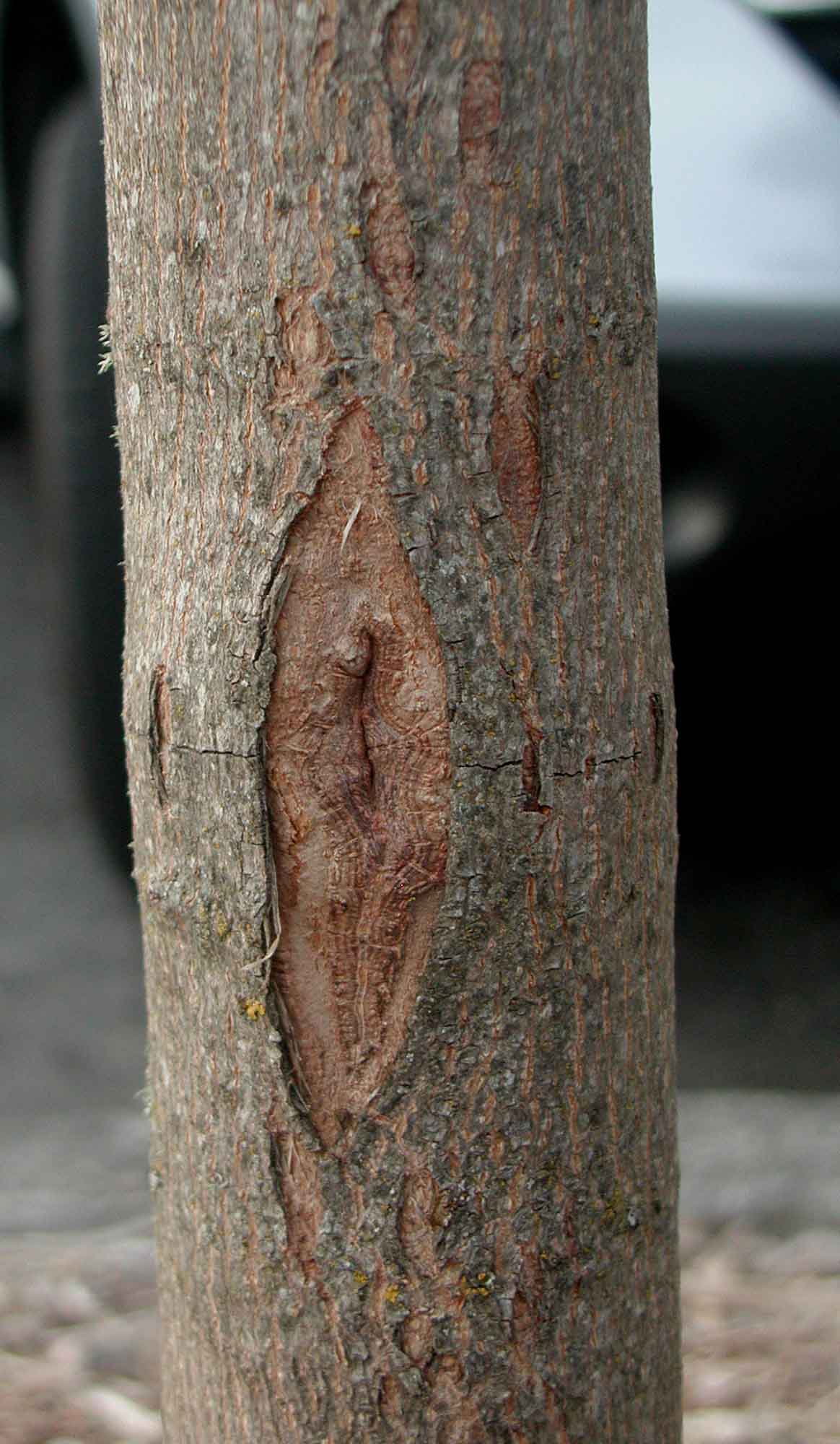
How can you tell if the tree you’re considering has been improperly pruned? Just look for those tell-tale pruning cuts, as a close examination of the lollipop tree reveal:

In time, these trees develop thicker bark, and the lower branches are gradually shaded out as the crown increases. Be patient! Let your trees be a little fuzzy when they’re young. They’ll grow out of it.
I think about these things as I peer into my coffee cup…
This winter, we’re working on renovating part of the campus Hort Garden. We’re tossing around lots of ideas/themes, but I’m leaning towards a garden full of “Plants with a Purpose”. Edible, fiber-producing, medicinal…you get my drift. Which brings me to today’s bloggerific topic: beverages.
Mankind has, throughout history, infused or fermented just about every species of flora in an effort to get either perked up or calmed down. These plant potions are often classified anthropologically as, ahem, “ceremonial beverages”. The species that we currently rely on for our daily ups and downs are not native to North America. But that’s not always been the case.
Way before the joys of coffee hit these shores, there was the Yaupon holly (and I am partial to hollies). This thicket-forming evergreen shrub likes “wet feet” and is usually found in marshy areas in the piedmont and coastal plains of the southeast. Translucent red berries grace the female plants in winter – hollies are dioecious, meaning male and female flowers reside on separate plants. The fact that Yaupon is one of few native plants to contain caffeine was picked up on very early by Native Americans – a potent tea brewed from the leaves was called the black drink. Though the scientific name Ilex vomitoria might indicate some unpleasant side effects, it only exhibits emetic properties when a ridiculous amount is consumed.
Sassafras (Sassafras albidum) has been used as both a flavoring and as the main ingredient in teas and soda. The sassafras is a sweet little understory tree, with oddly and variably shaped leaves – with one, two, or three lobes – Dr. Dirr at UGA pointed out to us that they often resemble “racoon mittens” Native throughout the Appalachians, the tree roots were dug up in early spring before while still loaded with sap (where’d ya think they got the name “root beer” from?!). Safrole is the phenolic compound that produces the characteristic flavor. However, safrole is now considered a carcinogen and the FDA banned the sale of sassafras for human consumption in 1976. Extracts used in food and beverages have to be “safrole free” – produced through a commercial process. It’s also a psychoactive compound. This may explain Yosemite Sam’s obsessive-compulsive tendencies and Saturday morning profanity (and I quote) “Rassan, sassan, sassafrasan…”.
Last in today’s line-up of stuff from the woods: Humulus lupulus (the vowel-heavy name for hops). Mmmmm, hops. Here ye, the one or two people that may not know this, that from hops cometh the essential oil that maketh beer yummy. Speaking of oils, get close enough to hop vines on a really warm day and you’ll get a whiff of why it’s in the family Cannabaceae. This perennial vine is native to most of the Northern Hemisphere. The European beer-making strains have naturalized – that is, has spread from plants brought over by colonists in the mid 1600’s. Hops are also dioecious – the female flowers are papery cones about the size of a quarter and the source of all hoppiness (the male flowers are basically useless and just sit around with their feet on the coffee table). The leaves are sandpapery and most have three lobes – sort of reminiscent of a grape leaf. Not only useful to make ceremonial beverages, the vigorous leafy vines provide an excellent screen and can quickly cover up an unsightly fence, shed, or family member. Now that’s a useful plant!
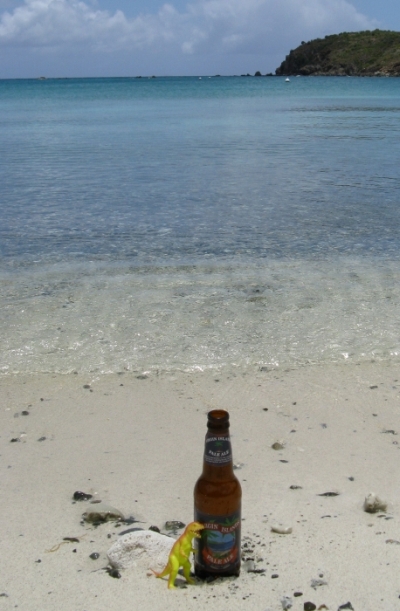
I spent so much time writing this I ran out of time to hunt for plant photos. So here you go: My traveling T.Rex enjoys a nice, hoppy Virgin Islands Pale Ale on a lovely beach in St. John.